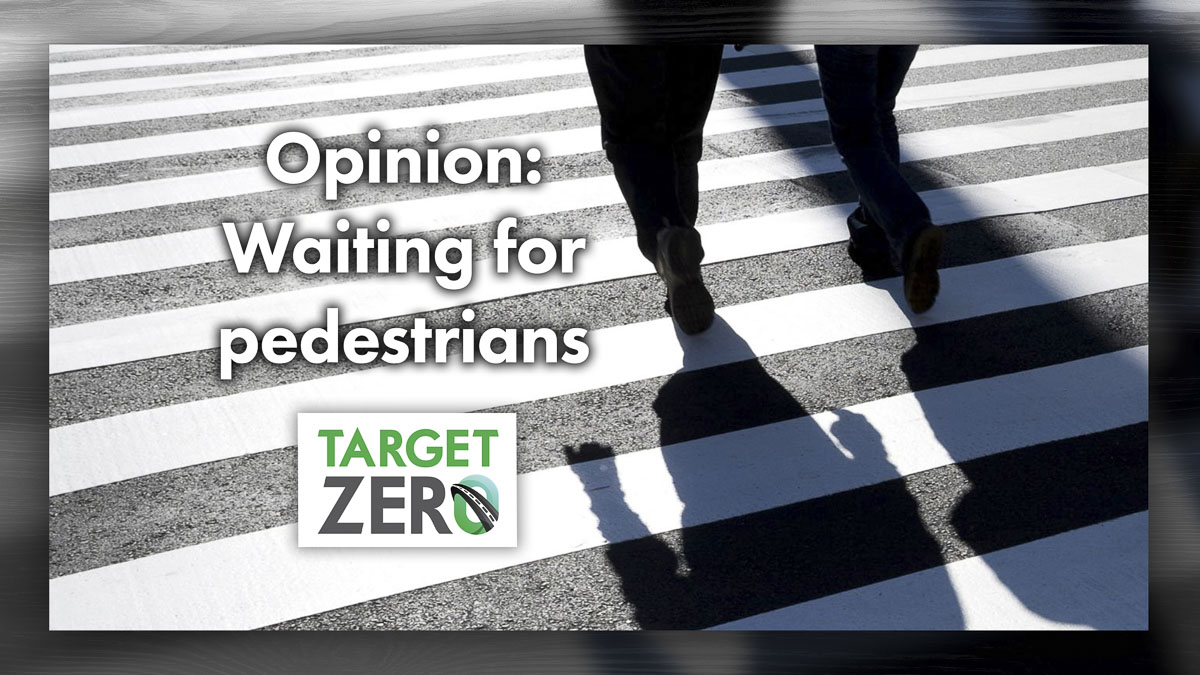
Target Zero Manager Doug Dahl answers a question about the need for cars to stop for pedestrians
Doug Dahl
The Wise Drive
Q: I know that cars need to stop for pedestrians at any intersection whether there is a marked crosswalk or not. But beyond that, when a pedestrian is crossing a street and a car stops, how far across the street should the driver let the pedestrian get before the driver starts moving again? Do you let the pedestrian get all the way across? Is enough if they are now in the other lane of the street?
A: Have you ever read something in English and felt after reading it that you might as well have been reading it in Klingon? That was me the first time I read the law that applies to your question. (I’m assuming no one reading this knows Klingon, but maybe I’m unaware of an overlap in the Star Trek nerd/traffic safety nerd Venn diagram.)

Before we get into the details of the law, I want you to visualize stopping for a pedestrian. I’d be willing to wager that you saw yourself coming to a stop at a crosswalk and a pedestrian crossing the street directly in front of you. That’s what I visualize too. But when we approach the typical intersection, there are three other crosswalks with potential pedestrians. Yes, we’re stopping for the one directly in front of us, and we’re also stopping for pedestrians at the additional crosswalk we’ll be driving through as we go through the intersection.
And now, the law. Or at least a paraphrase of it. In an effort to provide clarity, I often quote the law. I’m not going to do that today, because I don’t think it’ll help. If you doubt me, or just want to read the law, you can find it in the Revised Code of Washington in Title 46, chapter 61, section 235. Give the first sentence a try and let me know how it goes.
For the rest of us, here’s what’s in the law: You’re required to stop for a pedestrian that’s on your half of the roadway and for a pedestrian that’s within one lane of your half of the roadway. On a road with one lane in each direction, that would mean waiting for the pedestrian to cross both lanes. On a road with two lanes in each direction, if the pedestrian is crossing your half of the road first, you’d wait until they’ve also crossed one lane in the other direction. If they’re crossing the other half of the road first, once they’re within one lane of your half, you’re required to stop for them. These rules apply for the crosswalk right in front of you and the one across the street from you, or if you’re turning, the one you’re turning onto.
I’ll also point out that you shouldn’t think of half here as 50 percent. In this law, “half of the roadway” means all the lanes carrying traffic on one direction, so your math skills won’t help you here. If you’re at an intersection with two lanes in each direction plus a left turn lane, half of the roadway is either 60 or 40 percent. And on a one-way street, half of the roadway is also the entire width of the roadway.
But you don’t need to understand the relationship between math and traffic law. Fundamental to everything we’re talking about here (or as the law says, “Notwithstanding the foregoing provisions of this chapter”), it is the job of every driver to “avoid colliding with any pedestrian upon any roadway.” The rest of the laws about driver/pedestrian interactions are essentially explanations of how to abide by this rule.

TheWiseDrive is hosted by Doug Dahl, a Target Zero manager for the Washington Traffic Safety Commission.
Also read:
- Letter: ‘We’re going to give them some money and a plane ticket, and then we’re going to work with them’Camas resident Anna Miller supports a new structured self-deportation policy, calling it a balanced approach to immigration and economic needs.
- Opinion: What the 2025 legislature tells us about why Washington’s government keeps failingTodd Myers of the Washington Policy Center argues that Washington’s government fails because it resists humility, experimentation, and accountability in its policymaking.
- Letter: Vancouver needs broader leadership than just a teacher’s lensVancouver resident Peter Bracchi urges Mayor Anne McEnerny-Ogle not to seek another term, calling for more diverse and inclusive leadership rooted in broader experiences.
- Opinion: Legislative session ‘was full of ups and downs and many learning experiences’Rep. John Ley reflects on the 2025 legislative session, highlighting local funding victories and warning of major tax increases passed by the majority.
- Opinion: Washington state Legislature 2025: That’s a wrapElizabeth New (Hovde) of the Washington Policy Center breaks down the highlights and lowlights of Washington’s 2025 legislative session, warning of rising taxes and new mandates.










